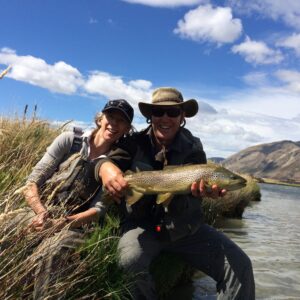For the love of giant trevally recounts my ongoing obsession with these fabulous fish. It’s a fascination that has seen me scour the globe looking for the next hot spot in which to target them.
In every fly fisherman’s journey, I think there comes a time when one species or another gets under your skin. It can be triggered by a particular experience, a certain trip or perhaps a slow understanding of what makes that species tick. Quite often this can then lead to a path of obsession unlike any other. For many it’s tarpon, for the unlucky few, it’s permit. For me, it’s giant trevally. These predatory behemoths stalk the flats of my dreams and often have me waking in a cold sweat.
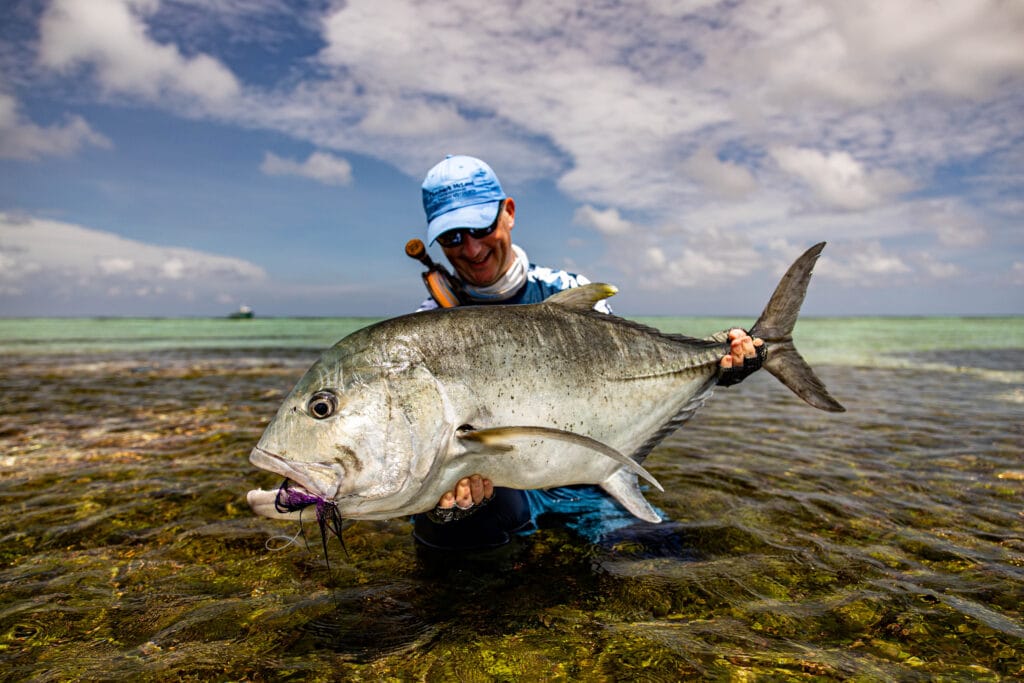
My obsession began on a wide edged ocean side flat on a far pin prick of land in the Indian Ocean in the early 2000s. I had stalked many a flat in the Caribbean over the previous decade, but this was my first venture onto the atolls of the Seychelles. There is a big difference between wading along hunting tails in calf depth water to taking the next step and wading from thigh to chest depth in the surf line. I was definitely out of my comfort zone. I was acutely aware that there are other hunters that patrol these areas, and my senses were electric. Just then, a wave set came in and there, framed in the wave like a picture, was a giant trevally surfing down the inside. The hunting instinct kicked in, I managed some resemblance of a cast and flopped the tan brush fly in its general vicinity.
The fish heard the fly land, did a 180-degree turn, hit the afterburner, annihilated the fly, and took off to the reef edge. Nothing prepares you for the speed and power of the take of a GT and the adrenaline rush is overwhelming. I am sure that my face mirrored all those emotions as I made first contact. Even though that first fish was by no means a monster, I was struggling to control it on a 12 weight as I floundered in between coral heads and the incoming waves. I managed to back up onto the edge of the flats, gain some traction, and finally apply enough pressure to prevent that fish heading over the edge and certain destruction.
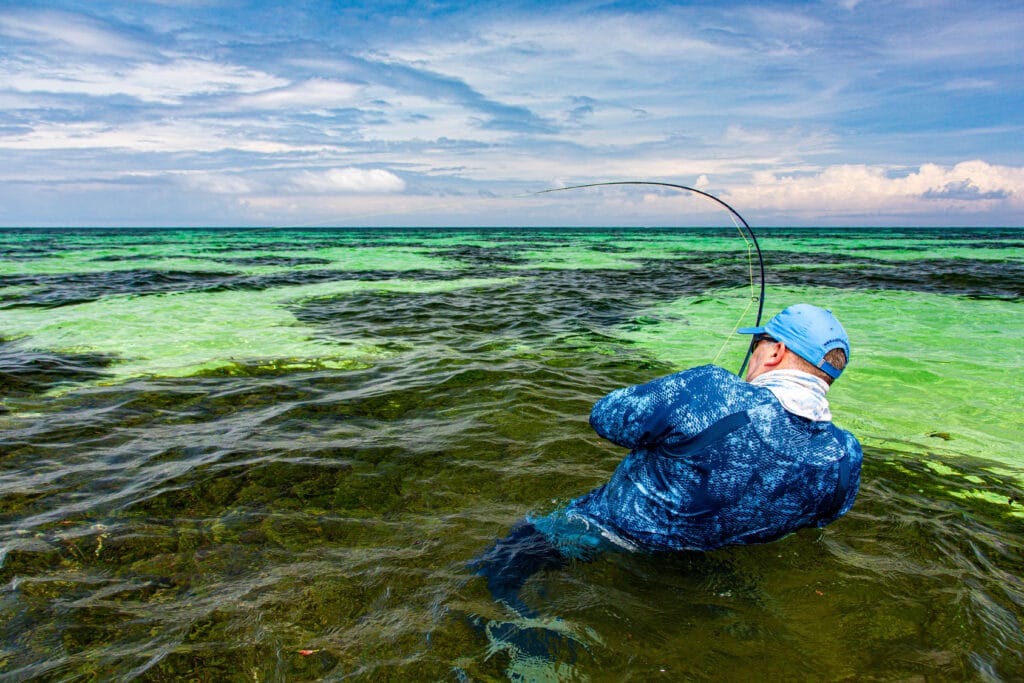
What is it that makes these fish so highly regarded as a target saltwater species? Bonefish are more honest, tarpon get bigger, and permit are definitely wilier. The first is their adaptability. GTs are incredibly opportunistic hunters. They will use everything at their disposal to feed on a huge variety of different prey species. One minute they are smashing bait in packs off beaches, the next they might be tailing on crabs on the flats and a little later they will be hovering on the back of a ray smashing anything it happens to scare up. They even target full grown birds off the surface. For a fly fisherman this makes them a phenomenal species to target, as every experience you have with them is different.
The environment in which you fish also plays a huge role. There is a big difference between polling around on a skiff to chase fish as opposed to immersing yourself in their environment. I have always preferred to wade when saltwater fishing for this reason. You become so much more aware of all the living creatures scuttling around at your feet, you feel the tide pushing in and out as it tugs at your shorts and when you come off the flats and fish the surf line sometimes it is a battle to just stay on your feet, let alone put a line out. You also develop what I refer to as the “Cosmoledo sweep”. When you are scanning from left to right looking for fish, it is the practice of every third scan looking behind you as well to make sure that there is nothing creeping up on you.
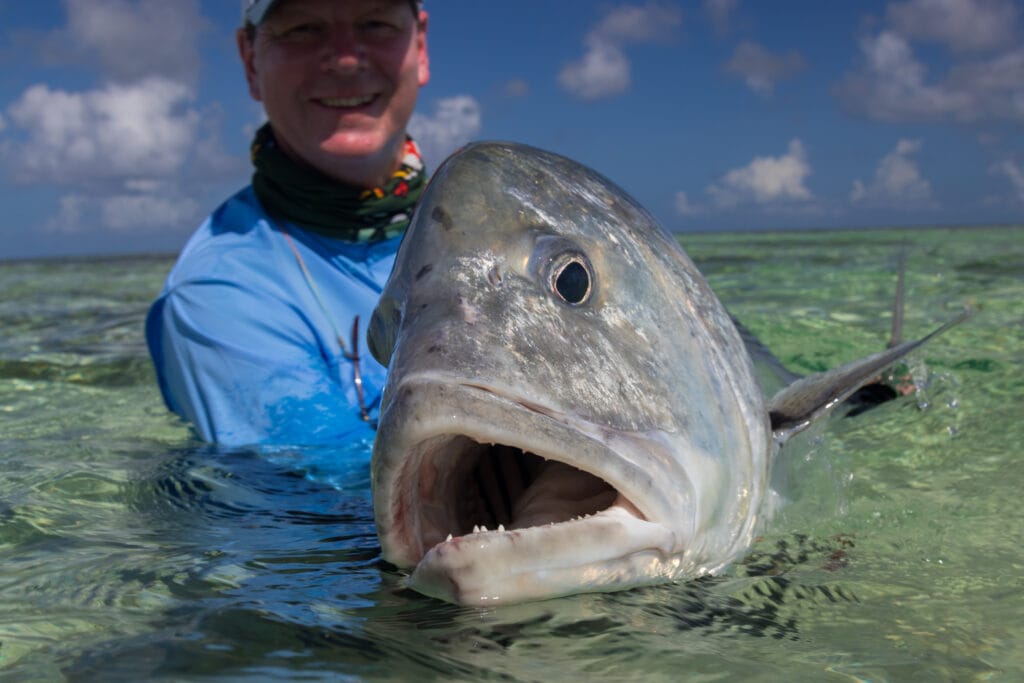
There was a time on Farquhar Atoll, when I waded out through some slightly deeper water to get to a headland with my guide. We crossed an area of rather crunchy shingle to reach it and just as the gradient rose and we hit knee depth we turned around to find a metre plus GT sliding in behind us. The noise of our boots had alerted it, and we were being investigated as a potential snack! I know this might sound rather alarming, but once you are accustomed to it and have been under the tutelage of guides that deal with it every day, the fear quickly evaporates. If someone told me when I first began fishing for this species that when I saw a shark on the flats, I would run towards it instead of away from it I would have thought them mad. GTs will often hang behind a shark and feed off any prey it spooks in a sort of grotesque game of grandmother’s footsteps.
The speed that GTs exhibit when hunting will take your breath away. This combined with their ability to track a moving object in the air is astounding. I have seen instances of a GT tracking a fly in the air as it is cast and intercepting it as it hits the surface, a technique that comes in very handy when hunting birds on the wing.
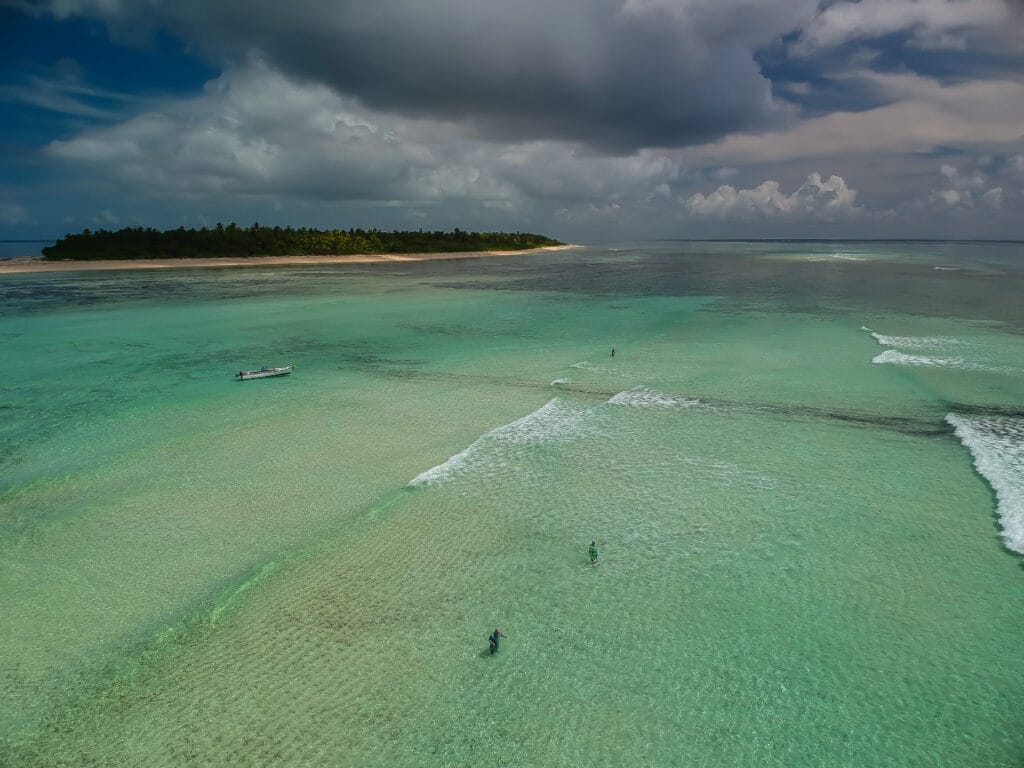
Picture finally making it into the flats after months of preparation. You are wading in thigh depth water and your guide points out a stingray with a GT on its back some 20 yards away. The heart is pounding, the legs shaking slightly. You strip off some line, throw out the 6/0 fly attached to the 130lb mono attached to the 12 weight rod that still feels like a broom handle. You begin to cast across the wind backhand, desperately trying not to stick that large hook into yourself and after a couple of attempts manage to put the fly somewhere near the ray. While you are trying to grab the loose line, remember to take up the slack and strip like the guide told you, the fish has charged off the ray and hit the fly. Without missing a beat, it is already disappearing into the blue as a stray loop of running line whips up, wraps around the rod butt, comes tight and wraps around the reel foot. Bang! The 50lb cored fly line parts like a gunshot going off and it’s all over… another one chalked up to experience. Sometimes they charge the fly so fast coming towards you it’s simply impossible to maintain contact with the fly and they spit it out before you ever come tight.
There seems to be a misconception around these fish that they always smash everything thrown in their general direction. This is not the case by any means and GTs have the same innate ability to drive you mental as every other gamefish. With tarpon you often have to convince them eat by using the retrieve and the mobile materials in the fly patterns. It is possible to “feed” a tarpon or a permit and occasionally this is possible with GTs as well, especially the big ocean-going fish. They are big for a reason and often they can be lazy with flies, tracking them for some time before finally committing. Other times they will just point-blank refuse which perhaps can be down to tidal phase or barometric pressure. This is more of a hunch than proven fact. If they ate everything the challenge would be gone, and it would not be as beguiling as it is.
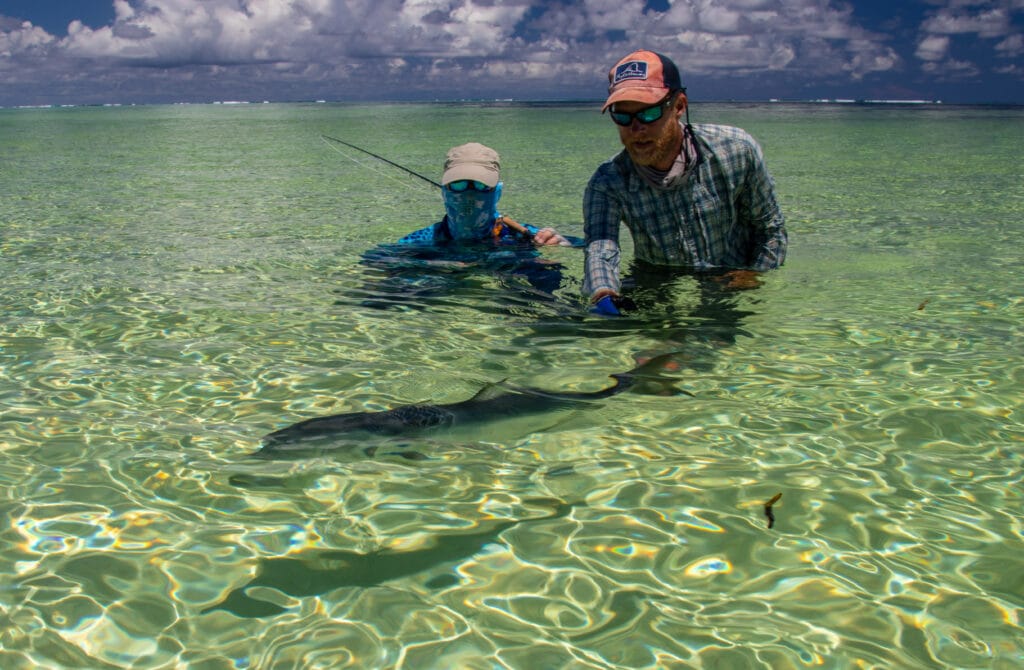
There is no doubt that hunting GTs is challenging. It is not the kind of species that you can just decide to go and catch. It does take some preparation and ability. I say this as encounters can still be few and far between and often require covering huge areas to locate the right phase of tide and prey species. You will need to put the time in to experience the reward and there is no instant fix. The key is to capitalise on the opportunities when they occur. Don’t attempt to fish for GTs with sub-standard kit or they will destroy it. It helps hugely to be proficient at double hauling with a 12 weight and big flies, both forehand and especially backhand. Invariably they are coming at you across the wrong shoulder. Casting this rig while standing up to your waist in water is a skill in itself and takes some getting used to. Longer belly lines allow you to pick up and put down a misplaced cast and it’s very different to firing a short bellied line off the front of a skiff. Although easier to turn over big flies, short bellied lines will make life harder as they require you to strip in the thin running line before recasting, by which time the fish has normally gone. Managing the running line also becomes an art in moving water, especially if it sinks as it will get caught on the coral. Mastering these skills is one of the most rewarding facets of fly fishing for GTs.
Every so often while wading the flats or the edges you encounter a beast. In GT terms this is generally considered to be over one metre in length which equates to some 45lb. This is a fish that has a mouth that can open nearly a foot in diameter and could easily swallow a chicken whole. If you spend enough time on the flats, you will probably tangle with one, and what happens next can often be a blend of skill, luck, and more often than not it ends in tears. The first time it happened to me will forever be etched in my mind. We were moving down on the large sand flats on the east side of Providence Atoll in the Seychelles. The lagoon system was on our left and we were right up on the apex of the flat. Coming down tide I spotted something large and black heading in our direction. I was not sure if it was a ray as it was very wide, but prepared myself as there might be a fish on its back. As we got close it dawned on me that it was not a ray at all, but a massive GT.
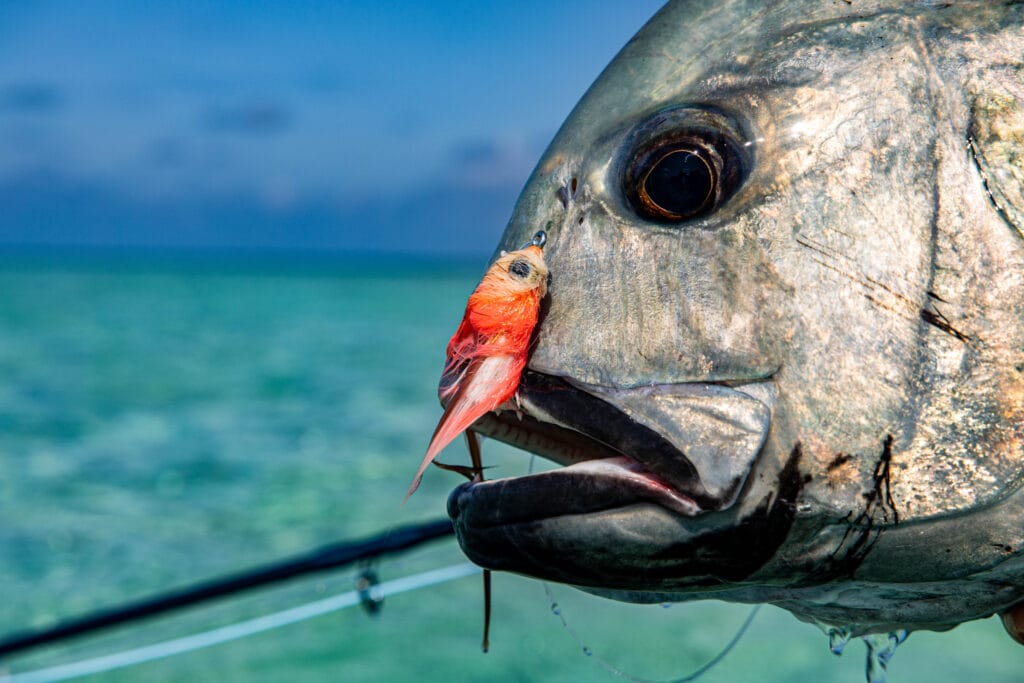
I threw the Olive Semper fly in front of me to clear the line and began to cast. As the distance closed, I dropped the fly two feet in front and slightly to the left of the fish. This would mean my retrieve would pull the fly away from it at an angle, much like a fleeing bait fish. I let the fly sink for a few seconds and gave it one long strip. The fish flared immediately and turned in that direction. I found myself holding my breath as I started to strip, long smooth pulls. The fish followed and on the third strip, committed. It accelerated and planed up on its fins as it engulfed the fly, its whole head out of the water as it eyeballed its prey. As it turned, I pointed the rod straight at the fish and hit it hard twice. The water erupted, the fish immediately charging for the safety of the deep water in the lagoon. The line hit the reel in a fraction of a second, line peeling off the spool as it made a tortured scream. I bent the rod to the opposite side and as I attempted to gain control, I felt the unmistakable feeling of line grating against coral heads. It neatly threaded my fly line through the coral heads like knitting until everything went solid. My shoulders slumped; the battle was over.
These “gangsters of the flats” are found in some of the most beautiful places on the planet and have a very large footprint. They are found in the Indian Ocean across through Australasia and the Pacific. I have had the joys of hunting them from Christmas Island in the Pacific, Indonesia, Sudan, the Seychelles, Mozambique and South Africa. Each destination has its own challenge, culture and technique, each teaching you something different about these magnificent creatures. I have travelled to fish for them every year for the last 20 years and I shall carry on dreaming until once again I step off the edge of the tender boat into that azure water, 12 weight in hand.
Where to catch giant trevally
The outer islands of the Seychelles are undoubtedly one of the best areas to target giant trevally on the fly. These remote atolls can offer some exceptional opportunities to target this great species on the flats. Not only this, but all these atolls offer fishing for a wide range of other species to catch. For more information on fishing in the Seychelles click HERE.
Where is the best giant trevally destination for you?
Several destinations offer anglers the opportunity to cast a fly at giant trevally. If you would like more information please contact Charlotte Chilcott or Peter McLeod or call us on +44 1980 847389. Alternatively click HERE if you would like us to contact you.
About the Author: Peter McLeod has worked in flyfishing travel for over 20 years, visiting over 60 operations in 20 different countries in his quest to find the finest fly fishing experiences available. He founded Aardvark McLeod international flyfishing specialists in 2005. His fascination with trevally species is bordering on the obsessive and he is constantly scouring the globe for that next mind-blowing hotspot to target these bull dogs of the flats.

